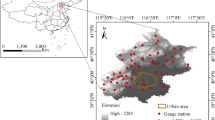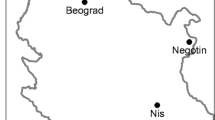Abstract
A climate system is characterized to be a complex non-linear system. In order to describe the complex characteristics of precipitation series in Paraíba State, Brazil, we aim the use of sample entropy, a kind of entropy-based algorithm, to evaluate the complexity of precipitation series. Sixty-nine meteorological stations are distributed over four macroregions: Zona da Mata, Agreste, Borborema, and Sertão. The results of the analysis show that intricacies of monthly average precipitation have differences in the macroregions. Sample entropy is able to reflect the dynamic change of precipitation series providing a new way to investigate complexity of hydrological series. The complexity exhibits areal variation of local water resource systems which can influence the basis for utilizing and developing resources in dry areas.









Similar content being viewed by others
References
Chen W, Zhuang J, Yu W, Wang Z (2009) Measuring complexity using fuzzyen, ApEn, and SampEn. Med Eng Phys 31(1):61–68
Chou CM (2014) Complexity analysis of rainfall and runoff time series based on sample entropy in different temporal scales. Stoch Env Res Risk A 28(6):1401–1408
Clark PU, Alley RB, Pollard D (1999) Northern hemisphere ice-sheet influences on global climate change. Science 286(5442):1104–1111
Costa M, Peng CK, Goldberger AL, Hausdorff JM (2003) Multiscale entropy analysis of human gait dynamics. Physica A: Stat Mech Appl 330(1):53–60. https://doi.org/10.1016/j.physa.2003.08.022
De Sousa EP, da Silva VD, da Cunha Campos JH, de Oliveira SD (2012) A teoria da entropia na análise da precipitação no estado da Paraíba. Rev Bras Geogr Fís 5(2):386–399
Dong L, Meng L (2013) Application of sample entropy on measuring precipitation series complexity in Jiansanjiang Branch Bureau of China. Nature Environment and Pollution Technology 12(2):249–254
Hastenrath S (2012) Exploring the climate problems of Brazil’s Nordeste: a review. Climate Change 112:243–251. https://doi.org/10.1007/s10584-011-0227-1
Huang F, Xia Z, Zhang N, Zhang Y, Li J (2011) Flow-complexity analysis of the upper reaches of the Yangtze River, China. J Hydrol Eng 16(11):914–919. https://doi.org/10.1061/(ASCE)HE.1943-5584.0000392
IPCC, Climate change (2014) synthesis report. In: Core Writing Team, Pachauri RK, Meyer LA (eds) Contribution of working groups I, II and III to the fifth assessment report of the Intergovernmental Panel on Climate Change. IPCC, Geneva, p 151
Lake DE, Richman JS, Griffin MP (2002) Sample entropy analysis of neonatal heart rate variability. Am J Phys Regul Integr Comp Phys 283:789–797
Lim KP, Brooks RD, Hinich M (2006) Testing the assertion that emerging Asian stock markets are becoming more efficient. SSRN Working Paper Series. https://doi.org/10.2139/ssrn.906515
Liu B, Chen X, Lian Y, Wu L (2013) Entropy-based assessment and zoning of rainfall distribution. J Hydrol 490:32–40
Lucena DB, Servain J, Gomes Filho MF (2011) Rainfall response in northeast Brazil from ocean climate variability during the second half of the twentieth century. J Clim 24(23):6174–6184
Maruyama T, Kawachi T, Singh VP (2005) Entropy-based assessment and clustering of potential water resources availability. J Hydrol 309(1):104–113
Milly P, Wetherald R, Dunne K, Delworth T (2002) Increasing risk of great floods in a changing climate. Nature 415:514–517
Mishra AK, Özger M, Singh VP (2009) An entropy-based investigation into the variability of precipitation. J Hydrol 370(1):139–154
Nóbrega JN, dos Santos CA, Gomes OM, Bezerra BG, Brito JI (2014) Eventos extremos de precipitação nas mesorregiões da Paraíba e suas relações com a TSM dos oceanos tropicais. Rev Bras Meteorol 29(2):197–208. https://doi.org/10.1590/S0102-77862014000200005
Ochoa A, Pineda L, Crespo P, Willems P (2014) Evaluation of TRMM 3B42 precipitation estimates and WRF retrospective precipitation simulation over the Pacific–Andean region of Ecuador and Peru. Hydrol Earth Syst Sci 18:3179–3193. https://doi.org/10.5194/hess-18-3179-2014
Rajagopal AK, Teitler S, Singh VP (1987) Some new perspectives on maximum entropy techniques in water resources research. Hydrol Freq Model 30:347–366
Richman JS, Moorman JR (2000) Physiological time-series analysis using approximate entropy and sample entropy. Am J Phys Heart Circ Phys 278(6):2039–2049. https://doi.org/10.1152/ajpheart.2000.278.6.H2039
Schuangcheng L, Qiaofu Z, Shaohong W, Erfu D (2006) Measurement of climate complexity using sample entropy. Int J Climatol 26(15):2131–2139. https://doi.org/10.1002/joc.1357
Silva M, Carvalho L, Dias MDS, de MBS Xavier T (2006) Complexity and predictability of daily precipitation in a semi-arid region: an application to Ceará, Brazil. Nonlinear Process Geophys 13(6):651–659
Tongal H, Berndtsson R (2017) Impact of complexity on daily and multi-step forecasting of streamflow with chaotic, stochastic, and black-box models. Stoch Env Res Risk A 31(3):661–682
Zhou R, Yang C, Wan J, Zhang W, Guan B, Xiong N (2017) Measuring complexity and predictability of time series with flexible multiscale entropy for sensor networks. Sensors 17(4):787
Funding
This work was funded by Coordination for the Improvement of Higher Education Personnel (CAPES) [Coordenação de Aperfeiçoamento de Pessoal de Nível Superior] (process 99999.006680/2015-01). The authors are grateful to the CNPq for the Research Productivity Grant, as well as CAPES, for funding the Research Project 88887.091737/2014-01.
Author information
Authors and Affiliations
Corresponding author
Rights and permissions
About this article
Cite this article
Xavier, S.F.A., da Silva Jale, J., Stosic, T. et al. An application of sample entropy to precipitation in Paraíba State, Brazil. Theor Appl Climatol 136, 429–440 (2019). https://doi.org/10.1007/s00704-018-2496-3
Received:
Accepted:
Published:
Issue Date:
DOI: https://doi.org/10.1007/s00704-018-2496-3




